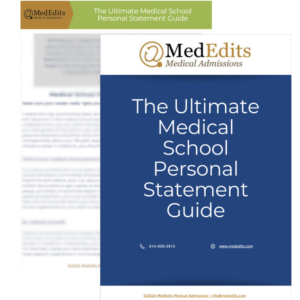
How to Write a Medical School Personal Statement Outline
When creating your medical school personal statement outline, you must first have an idea of what life experiences and opportunities you want to write about. Your goal in writing your medical school personal statement is to tell your story in the most captivating way to explain why you want to be a doctor. This theme, why you want to be a doctor, is the theme for every medical school applicant’s essay. What will distinguish your personal statement is how you tell this story and what distinctive experiences and insights you highlight.
Medical School Personal Statement: A Narrative-Based Essay
“Ensure that your essay is interesting, follows a logical and orderly flow, and relates to your reasons for choosing medicine and why you believe you’ll be successful in medical school and as a physician.” The Association of American Medical Colleges
- Have an engaging and vivid opening hook. This means they start with a story that is compelling and interesting and allows the reader to be in your shoes, hearing what you hear, feeling what you feel, seeing what you see.
- Use specifics. You don’t want to use general descriptions or ideas that anyone else could write.
- Communicate a clear point of view that helps the reader understand what is important to the author, what moves you, and why the reader should be invested in your story.
- Express Ideas, values, and insights that are central and clearly important to you.
- Have a logical progression.
- Elicit emotion, feeling, and connection in.
- Offer a distinctive perspective about otherwise typical experiences.
- Communicate the author’s strong voice and personality based on an authentic writing style.
- Merge effective storytelling with meaningful reflections.
- Showcase growth, maturity, and understanding.
Writing Your Medical School Personal Statement Outline
Paragraph 1: Determine what your hook or opening story will be. To do this, we advise you to complete the MedEdits’ Personal Inventory Exercise. Use vivid language to evoke as much sensory detail as possible to really draw your reader into the vignette.
Paragraph 2: Reflect on the significance of the story you told in Paragraph 1. What insights did you gain from this experience or how did it help you to grow? What effect did this experience have on you? How did this experience fit in with your overall path to medical school?
Body Paragraphs: In your body paragraphs, you want to detail the other personal, extracurricular, and scholarly milestones and experiences that are the most significant on your path to medical school based on the work you did in the MedEdits Personal Inventory Exercise. Be sure that at least some of the topics you choose to write about support the Foundational Statement you crafted in the Personal Inventory Exercise.
As you write about these most important events, do your best to reflect and explain, in your own strong voice, what you learned from each, how they contributed to your growth as a person and a premedical student, the impact each had on you, and how they paved your path to the current day. You also want to make sure that your progression is clear and helps the reader understand how each experience motivated you and informed your decisions or path forward
Conclusion: Often, but not always, students return to their opening story in their conclusion. If there is something left “unresolved” in the story or if what the student discovered about themselves is something they want to reflect on in the current day as it is still applicable, this can be a really effective strategy. The strongest conclusion offers new insights and at least a hint of the emotional significance of how your experiences have impacted you. You want to use your conclusion to summarize the lessons you have learned from your most pivotal experiences and how that has informed who you want to be as a medical student and, perhaps, as a physician. For help on this, complete the MedEdits Mentor Exercise.
Medical School Personal Statement Writing and Revising
Once you have composed your medical school personal statement outline, start writing. This is sometimes the most difficult part of this process.Take time in your writing. Once you have a first draft, let it sit for a few days, or maybe even a week or two. Go back and see what you think can be improved. Review and revise until you are happy with your final result. And, if you are interested in professional help, feel free to reach out to us!
Note:
Personal statement character limits for different medical school application systems:
AMCAS: 5300 characters with spaces
AACOMAS: 5300 characters with spaces
TMDSAS: 5000 characters with spaces

JESSICA FREEDMAN, M.D., a former medical school and residency admissions officer at the Icahn School of Medicine at Mount Sinai, is the founder and chair of MedEdits Medical Admissions and author of three top-selling books about the medical admissions process that you can find on Amazon.


